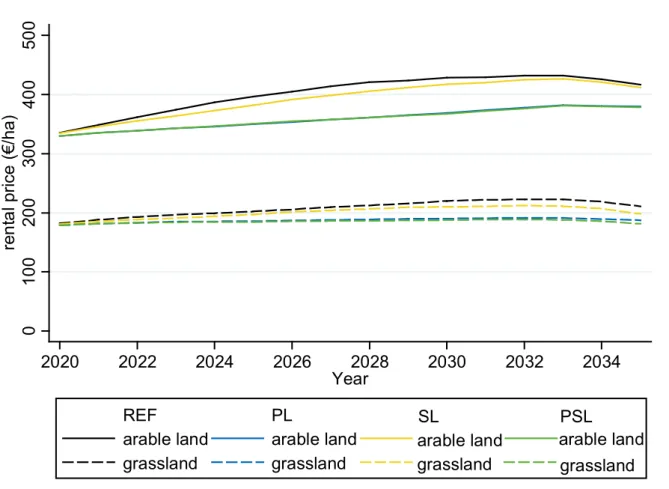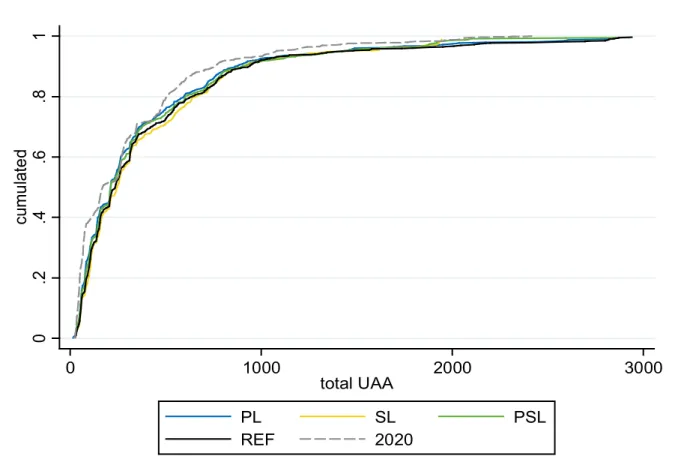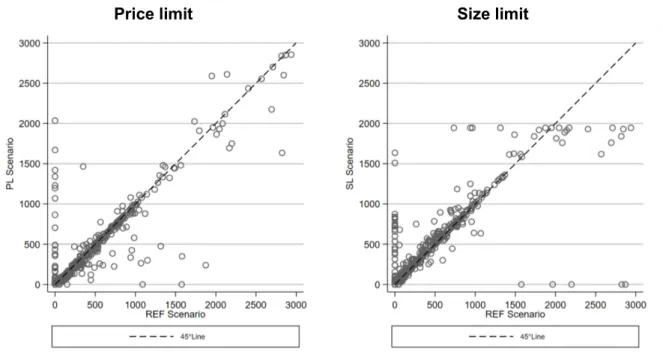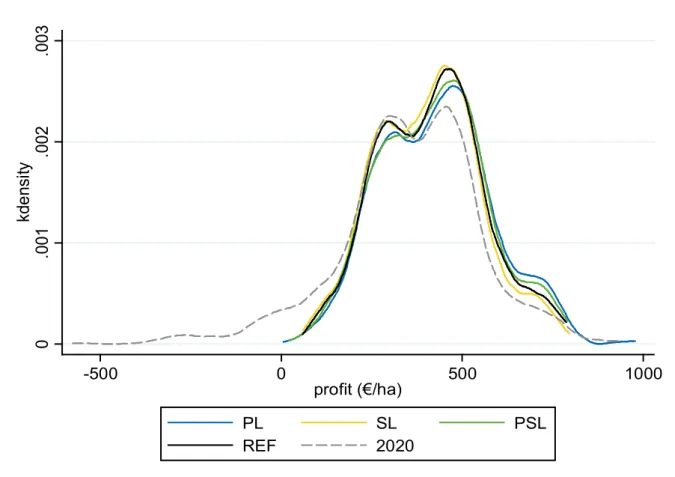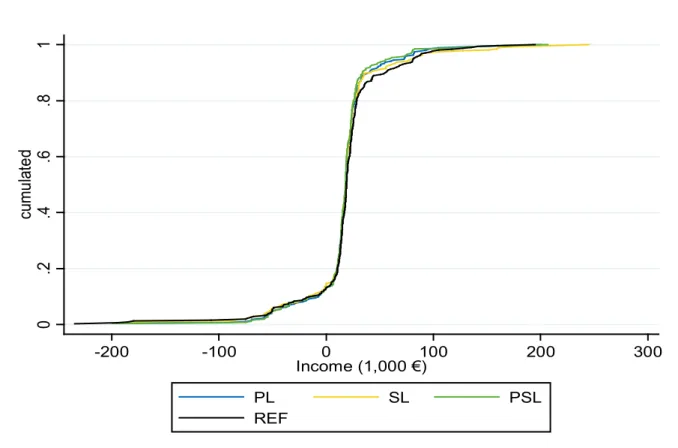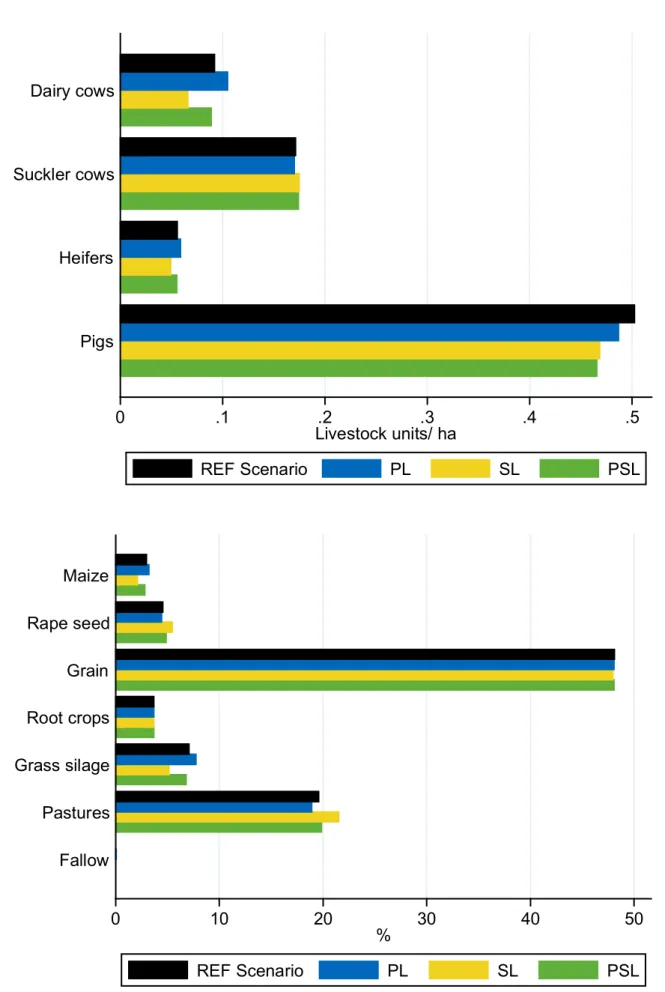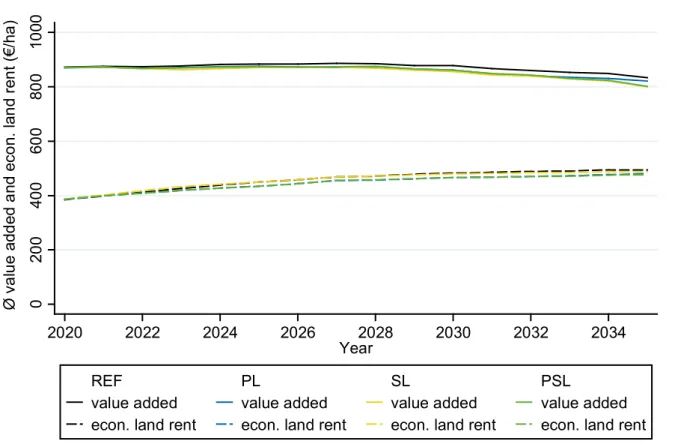Published by
DFG Research Unit 2569 FORLand, Humboldt-Universität zu Berlin Unter den Linden 6, D-10099 Berlin
https://www.forland.hu-berlin.de
Tel +49 (30) 2093 46845, Email gabriele.wuerth@agrar.hu-berlin.de
A gr icul tur al Land M ar ket s – E ffici ency and R egul ati on
Can Land Market Regulations fulfill their Promises?
Florian Heinrich, Franziska Appel, Alfons Balmann
FORLand-Working Paper 12 (2019)
Can Land Market Regulations fulfill their Promises?
Florian Heinrich
∗, Franziska Appel
∗∗, Alfons Balmann
∗∗∗December 2019
Abstract
After land prices in Germany increased continuously since 2006, policy makers, representatives of farmers’ unions, NGOs, and farmers started and continued to discuss or propose new land market regulations to stop price increases and to protect particularly smaller farmers. In this paper we analyze different types of regulations for the land rental market with the agent-based model AgriPoliS. Our simulation results show that price and farm size limitations may inhibit rental price increases and reduce structural change. The regulations do however not lead to a conservation in the number of small farms; neither do they have a substantial positive impact on their profitability and competitiveness. Many small farms still exit agricultural production and only few are able to grow into a larger size class. Beyond redistributional costs, e.g. beared by landowners, economic and social costs result from reduced average economic land rents, less regional value-added and less employment caused by a reduced functionality of the land market and biased incentives.
Keywords: structural change; land market; land market regulation; agent-based modeling JEL codes: Q15, Q18, C63
Acknowledgements
Financial support from the German Research Foundation (DFG) through Research Unit 2569
“Agricultural Land Markets – Efficiency and Regulation” is gratefully acknowledged.
∗ Florian Heinrich, heinrich@iamo.de
∗∗ Franziska Appel, appel@iamo.de
∗∗∗ Alfons Balmann, balmann@iamo.de
All authors are at Leibniz Institute of Agricultural Development in Transition Economies (IAMO), Department of Structural Development of Farms and Rural Areas, Theodor-Lieser-Str. 2, D-06120 Halle (Saale).
1
Introduction and MotivationFor over a decade, rental and sale prices of agricultural land have risen in Germany, with an annual increase of up to 25% (Tietz and Forstner 2014). This trend is particularly apparent in the east of Germany, although the prices are still lower than in Western German regions (BMEL 2015). Due to the price developments on the land market, many farms, especially smaller family operated farms are concerned about losing their ability to compete on the land market.
Their fear is that it would result in loss of their viability and a forced exit of the sector (Langenberg and Theuvsen 2016; DNN 2019).
The situation has triggered discussions on land market issues amongst stakeholders, such as farmers, NGOs, the public, the media, policy makers and scientists (e.g. Odening and Hüttel 2019; Top Agrar 2019a; Agra-Europe 2018a,b,c; Bauernstimme 2018; Proplanta 2017).
Discussants point at potential reasons of this development, such as low interest rates for the sales market, the activity of non-agricultural investors or the political support of biogas production (Forstner et al. 2011, Langenberg and Theuvsen 2016, Appel et al. 2016). The rapid changes in land prices have prompted questions about whether the land market works effectively as an allocation device to serve societal interests and whether there is a need for political measures to reduce potential negative implications. In recent years, several legislative proposals were formulated at the federal state level in Germany. The proposed measures aim to increase the regulations around land transactions. In 2015, the Ministry Agriculture and Environment of the State of Saxony-Anhalt drafted a proposal which included maximum farm sizes (MLE LSA 2015). In 2017, the government of the German federal state of Lower Saxony proposed a law, “Gesetz zur Sicherung der bäuerlichen Agrarstruktur in Niedersachsen (Niedersächsisches Agrarstruktursicherungsgesetz – NASG –)” (NASG 2017), which aimed to preserve the family-based agricultural structure of the state. Central to both proposals were size limitations for farms within municipalities and price limitations. Although both proposals were not passed into law before new governments began their term in 2015 and 2017, the succeeding governments committed to regulate the land market more strictly (Koalitionsvereinbarung 2017; MLU LSA 2015). Currently, there are also ongoing initiatives on land market reforms in the states of Brandenburg (Top Agrar 2019b) and Thuringia (Fraktion DIE LINKE Thüringen 2019). For a number of years, there have been discussions about land acquisition via share deals of large agricultural enterprises (Forstner and Tietz 2013; Fraktion DIE LINKE Thüringen 2019). These are however not subject of this paper.
Some form of market regulation can be found on any market in industrialized countries.
Therefore, there is a large body of literature on market regulations in general (e.g. Joskow and Rose 1989; Winston 2006). Legal frameworks include at least rudimentary laws as how to design a contract; in our case for example land rental contracts. The demand for market regulations is predominantly motivated by the existence of market imperfections causing undesired outcomes. But such regulations themselves cause costs. These are the direct implementation costs as well as the indirect costs which can potentially influence the market performance and may even lead to a lower performance than if there was no invention.
Empirical results show that the effects of market regulations often differ from their promises (Joskow 2010). It can also be seen that regulated firms are substantially impacted in their behavior and performance.
In order to design a policy that is potentially effective to reduce the market imperfections, it is necessary to identify and quantify the imperfections first (Joskow 1989; Winston 2006). In a recent study, Croonenbroeck, Odening and Hüttel (2019) analyzed bidding behaviors of different actor groups on the land market. They did not find major differences across the actor groups which could justify land market regulations economically. Nevertheless, the idea of governmental regulations on the land market is popular amongst some stakeholders (Balmann 2015; Croonenbroeck, Odening and Hüttel 2019; Topagrar 2019c).
Even though the existing literature provides insights into the motives of land market regulations (Ciaian et al. 2012; Swinnen et al. 2016), there are few indications as to whether the promises of such regulations can be fulfilled. An example of such an analysis is provided by Latruffe et al. (2013) analyzing land market regulations in France with a focus on pre-emptive rights and SAFER. SAFER is the French land development and rural establishment agency. It oversees the land market and is able to interfere if agricultural structural goals are endangered. Latruffe et al. (2013) found that land transaction regulations have a negative effect on land prices.
However, they focused only on the sales market and did not account for subsequent effects of this result. We try to bridge this gap by using the agent-based model AgriPoliS as a tool to simulate land market regulations for the land rental market and compare several regulation scenarios ex-ante. Because political debates on stricter regulations are particularly intense in the eastern part of Germany, we focus on a case study region in the eastern German state Saxony-Anhalt, the Altmark.
2
Research questionsProponents of land market regulations have specific objectives in mind which they want to achieve through land market policies (Ciaian et al. 2012; Swinnen et al. 2016). Often, they want to prevent increases of land prices in favor of farmers. Others argue to support the competitiveness of traditional family-based farms against corporate farms or so-called non- agricultural investors which develop into farming through merger and acquisition but have no local or agricultural background. There are others who aim to prevent the emergence of local market power of large landowners or farming enterprises (Forstner et al. 2011; Deutscher Bundestag Drucksache 19/5887 2018; Umweltbundesamt 2019). Often, these arguments are linked to the goal to avoid a negative development of the agricultural structure (cf. MLU LSA 2015, NASG 2017) which is a further objective of the respective current law on agricultural land rentals, the LandPachtVerkehrsGesetz (LandPachtVG). According to the current legislation in Germany, land rental contracts can already now be rejected by local land regulation authorities if the contract (i) leads to an “unhealthy” allocation of land, (ii) leads to splitting up land plots to uneconomical sizes, and (iii) defines a land rental price which is not adequate to the revenue which can be achieved by sustainable farming practice. Up to now, these regulations are used in a rather liberal and market-oriented way. The recent proposals are however more specific. In the following, we analyze two types of regulations. These are
"price limits" for land and "size limits" for farms as well as a combination of both.
Important for assessing the outcome of regulations is the identification of indicators for costs and benefits. From an economic perspective, it can, for instance, be argued that higher land rental prices indicate higher benefits for the landowners, which is ceteris paribus positive for society. This would be the case if the higher rental prices just reflect increased economic or
Ricardian land rents which may result from technological progress. However, this may not be true if the rental prices result from an increased market power of landowners. Land prices and economic land rents may also increase because of structural change towards more efficient farms. In such cases landowners win, the more efficient farms may win, and less efficient farms may lose. In such a case, two conceptual views can be taken. One can apply the perspective of the Schumpeterian entrepreneur and creative destruction (Schumpeter 1941) which considers innovations as the driver of capitalism and at the end of economic growth.
Alternatively, one can apply the fundamentally similar but pessimistic perspective of the technological treadmill developed by Cochrane (1958). This theory argues that in agriculture, on the producer side only innovators benefit from technological progress while most farmers either have to follow or exit the market. The latter often affects smaller farms.
A more general perspective on the assessment would be to assess land market developments and regulations on criteria which indicate whether the agricultural sector maintains the ability (or is enabled) to fulfill its societal functions in providing private and public goods. Such a perspective has been suggested by Meuwissen et al. (2019) by developing a framework for the assessment of the resilience of farming systems. Criteria covered by AgriPoliS are for instance gross margins or value-added per hectare, share of farm income coming from agricultural production, share of forced exists, or total employment in agriculture (Meuwissen et al. 2019).
A fourth perspective could be derived from legal documents which formulate the objectives of land market regulations. For instance, the proposals for more rigid land market regulations in Saxony-Anhalt and Lower Saxony in 2015 and 2017 argued to justify price or farm size limitations by the intention to safeguard and improve the agricultural structure and specifically the competitiveness and sustainability of peasant family farms, to prevent further increases of land prices, to ensure the generation of value-added, to ensure fair incomes for farmers as well as to prevent market power and lack of competition (MLU LSA 2015, NASG 2017).
To assess the effects of price and size limitations, we examine the influence of these measures by simulations of the alternative policy regimes with the agent-based model AgriPoliS for a case study region in the northern part of Saxony-Anhalt, the Altmark region. AgriPoliS allows for endogenous structural change and particularly land rentals. The simulations generate data on the farm and regional level including distributions for a number of variables. These variables include the evolution of, e.g.,
- rental prices for arable and grassland, - farm sizes,
- profits, farm household income, - value added, gross margins, - economic (Ricardian) land rents, - and production and employment.
3
Methodological approach and case study region1 3.1 AgriPoliSThe agent-based model AgriPoliS (Agricultural Policy Simulator, Happe et al. 2006;
Sahrbacher et al. 2012) is a spatially explicit and dynamic agent-based model that is able to simulate the evolution of agricultural structures over time. It is mainly used to study the influence of agricultural policies on agricultural structural change. It originated from the work of Balmann (1997) who studied path dependencies in structural change in agriculture by the development and use of an agent-based approach. AgriPoliS has been adapted to several regions across the EU based on calibrations to empirically collected data and thus provides results of policy scenarios on structural change in real regions (Sahrbacher et al. 2012).
In AgriPoliS, a number of individual agents represent farms that interact in a synthetic landscape that maps agriculturally related regional and structural characteristics. The adaptation of AgriPoliS to the selected regions is achieved by specifying farm types that are typical for that region and which are weighted to match regional characteristics. Apart from the farms initial factor endowment and size, the selected farm types are differentiated in a stratification process during the initialization of a model run. According to the weight of the farm types, a proportional number of farm agents are randomly distributed in the spatial grid of land plots and initialized with individual management skills (i.e. different variable production costs) and ages of the farmer and farm assets. All farms are assumed to maximize profits (corporate farms) or household income (family farms) by use of a mixed-integer programming model that is linked to the selected farm agents data on factor endowments (fa cilities, labor, capital, land, management quality, etc.) as well as the various production and investment alternatives from which the farms can choose to maximize their profit. Farms can also extend their capacities by employing more workers. Furthermore, farms can borrow capital on a short- and long-term basis. Capacities can also be reduced by avoiding re-investment in depreciated stables. The provided investment and production activities can be considered as typical for the region and are calibrated such that in the beginning of each simulation, the derived farm agents choose the same or similar production activities as the real farms they represent (Appel et al. 2016). If farms are illiquid or if they are not able to cover their opportunity costs, they leave the sector but continue as agents in the model run by using their land, capital and labor for off-farm income (Kellermann et al. 2008). With AgriPoliS, we are able to track the financial situation of non-active farmers as well. This can be relevant particularly in land market questions because these agents benefit from rental payments for land which they rent out. Deeper insights into the actions and interactions of the agents within AgriPoliS can be achieved through the business management game FarmAgriPoliS (www.farmagripolis.de, Appel et al. 2019).
The land allocation process in AgriPoliS works as an iterative auction where free plots of land are allocated to farm agents that intend to rent additional land. A sales market is not yet implemented in AgriPoliS because in many countries, such as in Germany, farms predominantly grow by renting additional land (Happe 2004). Plots become available for rentals, when rental contracts expire or farms exit agricultural production. In the land allocation process, farm agents are asked to make a bid for their most favorable land plots. Their bids Rx,y depend on the shadow price qLandN of land and the distance TCx,y between the farmstead
1 Methodological section mainly based on APPEL et al. 2016.
and the next plot, certain agglomeration effects Cx,y. as well as a fixed multiplier β with 0<β<1 which represents the translation of the value of the plot into the bid.
𝑅𝑅𝑅𝑅, 𝑥𝑥 = 𝛽𝛽 ∙ (𝑞𝑞𝐿𝐿𝐿𝐿𝐿𝐿𝐿𝐿𝐿𝐿 − 𝑇𝑇𝑇𝑇𝑅𝑅, 𝑥𝑥 − 𝑇𝑇𝑅𝑅, 𝑥𝑥)
In an iterative auction, the bids of the different farms are compared. The agent with the highest bid receives the plot. Then the next round of bidding starts and so on. The allocation ends if there are either no plots available or if there are no further positive bids. The rental price for every plot is equal to the bid given in the land auction (first price sealed bid auction). The rental contract length varies randomly between a predefined minimum and maximum value which is typical for the modelled region. For the time of the contract length rental prices remain fixed.
3.2 The case study region
The simulations are conducted for the Altmark, which is located in the federal state Saxony- Anhalt in the north-east of Germany. Similar to other German regions, the Altmark can be considered as a region which has experienced steep land price increases in recent years. The region comprises the two districts Stendal and Altmarkkreis Salzwedel. The total area is 4,716 km2 of which 274,000 ha are Usable agricultural area (UAA) (STALA 2016). The Altmark is characterized by rather large farms, typical of north-east Germany. Many of the farms are specialized arable farms or mixed-farming with livestock production. There is a total of 1,070 farms operating in the region which farm on average 256 ha of land (STALA 2016). Compared to other districts in north-east Germany, the share of grassland (25%) is rather high (STALA 2016).
Ostermeyer (2015) provides a detailed description on how the Altmark region is implemented in AgriPoliS.
3.3 Scenarios/DOE
In this paper we focus on relevant land market regulation measures for Germany. They are derived from the NASG proposal (NASG 2017) and the non-published proposal of the state Saxony-Anhalt (MLU LSA 2015). We analyze four scenarios (Table 1). In a reference scenario (REF scenario), the region is modeled as previously in AgriPoliS without further land market regulations. In a second scenario (PL – price limit) the price for new rental contracts is limited.
Farm agents are only allowed to bid a maximum of 10% above the average rental price of a comparable plot in the region. The two differentiated soil qualities are arable land and grassland. If several farms offer the maximum bid, a lottery decides. The third scenario (SL - size limit) restricts the maximum farm size in hectare UAA, which may not exceed five times the current average farm size of the region. The scenario PSL (price-size limit) combines the two aforementioned scenarios.
Table 1: Land market regulation scenarios and implementation in the model
Scenario Description
REF (reference) - No further land market regulations
PL (price limit) - Maximum price for new rental contracts is not allowed to be more than 10% above the average for comparable plots in the model region.
- In the auctions, farms are only allowed to bid the maximum price. If several farms make the maximum bid, a lottery decides which farm receives the land. When rental
contracts of farms expire, the farms may lose land despite of high shadow prices.
SL (size limit) - The maximum farm size (in hectare UAA) may not exceed 5 times the average farm size of the region.
- In the auctions, only those farms can make bids which are smaller than the maximum size. Farms larger than the maximum size loose land when rental contracts expire.
PSL (price-size limit) - PL and SL implemented at the same time.
4
AnalysisEach of the simulations starts in 2016 and runs 20 iterations, i.e., until 2035. Based on the number of farms in Table 2, the entire region is simulated. We simulate without repetitions.
After an initialization phase, the regulation measures become active in the policy scenarios in 2020. The current political framework conditions of the Common Agricultural Policy (CAP) have been considered to continue after 2020. The analysis is focused on the period 2020 to 2035.
To analyze whether the price and size limitations meet their objectives, we consider the impact of these measures on the rental prices and the distribution of farm sizes, on profitability and income, as well as on production structure, value-added and efficiency.
4.1 Rental prices
Regarding the development of the rental prices (Figure 1), it can be seen that PL is quite effective in preventing a further rise in the rental prices compared to the reference, while the price effect in SL is small, which indicates that size limitations do not prevent fierce competition for land. In the year 2035, the rental prices for arable land in the PL scenario are approximately 9% (11% for grassland) below the reference scenario, while for SL the prices are only 1% lower for arable land (6% for grassland). Combining the two tools results in an even more significant reduction in land rental prices, which is 9% for arable land and 14% for grassland compared to the reference scenario in 2035.
Figure 1: Development of rental prices
4.2 Farm size distribution
As Table 2 shows, the regulations slow down structural change. While, by the year 2035, 32%
of the farms will exit production in the reference scenario, in the PL scenario only 28% of farms exit while 29% exit in the SL scenario and 27% in the PSL scenario. Accordingly, there is a substantial effect though the differences in farm survival occur in the long run.
Table 2: Number of farms by year and scenario
Scenario
Year REF PL SL PSL
2016 928 (100%) 928 (100%) 928 (100%) 928 (100%)
2020 858 (92%) 858 (92%) 858 (92%) 858 (92%)
2025 762 (82%) 771 (83%) 773 (83%) 774 (83%)
2030 706 (76%) 723 (78%) 725 (78%) 726 (78%)
2035 629 (68%) 664 (72%) 662 (71%) 673 (73%)
0100200300400500rental price (€/ha)
2020 2022 2024 2026 2028 2030 2032 2034
Year
REF PL SL PSL
arable land arable land arable land arable land grassland grassland grassland grassland
Beyond the pure development of the number of farms, the land market regulations aim to preserve the role of family-based agriculture and to avoid rising market power of the few very large farms. To check the effectiveness of this goal, Figure 2 shows the cumulated density function of the farm size distribution. Accordingly, the differences between the alternatives are rather marginal compared to the effects of the structural change which occurs in any case between 2020 and 2035.
Figure 2: Farm size distribution cumulated in 2035
The scatterplots of Figure 3 show the cultivated UAA per farm in the PL and SL scenario in comparison to the REF scenario in 2035 on the farm level. Farms that are on the 45°-line farm an equal amount of land in the REF scenario and the respective land market regulation scenario. This effect is approximately true for the very most farms. Farms underneath the 45°- line become larger in the REF scenario, while farms above the 45°-line are able to increase their land bank in the SL or PL scenario. Dots on the Y-axis mark farms which exit in the reference scenario while they survive in the policy scenarios. Some of these farms would farm even more than 1,000 ha in the regulation scenario. Dots on the X-axis mark farms which exit in the policy scenarios while they survive in the reference scenario. The different individual farm evolutions may result either from a relative low performance of the farms (e.g., because of low managerial skills) or from regulation effects on neighboring farms. Some farms which in the reference scenario range from medium size to very large, are much smaller in the PL scenario. Eventually, these farms suffer from the price limitation because the price limit prevents them to overbid neighboring farms despite of high shadow prices for land.
0.2.4.6.81cumulated
0 1000 2000 3000
total UAA
PL SL PSL
REF 2020
Figure 3: Farm sizes in 2035
Price limit Size limit
For the SL scenario, there is a clear size limit in the range of some 2,000 hectares. Some farms which grow beyond the size of 2,000 hectares in the reference scenario cannot do so with size limits. At the same time, many farms which are below 2,000 hectares in the reference scenario grow to the upper size limit. Although many smaller farms are benefitting from the size limits, relatively few grow substantially by more than 100 hectares. Accordingly, most farms that are initially below the size limit are not strongly affected.
Also in the PSL scenario, large farms are hindered in their development. However, the barrier to growth is not quite as clear here. For small farms there is no distinct effect.
4.3 Farm profitability
Land market regulations further affect the performance and financial success of farms. On a per hectare basis, Figure 4 shows that profits are increasing in all scenarios when comparing the stance in 2020 and 2035. The price limits in the PL and PSL scenarios cause profits per hectare to be a little higher than in the SL and the reference scenario. However, these effects are small compared to the differences between the farms. The beneficiaries of rental price limits are large and already profitable farms. Smaller and medium-sized farms do not benefit at all.
Because the profits per hectare give only limited insights regarding the total profitability of the farms, Figure 5 shows the cumulated distribution of the profits plus wages per active farm.
Again, compared to the initialization, all scenarios show a positive income and profitability effect of structural change on the income level which is resulting from exiting farms which are rather inefficient. Land market regulations like rental price and size limits have only a limited effect on incomes and the profitability of the farms.
Figure 4: Kernel density estimation of the farms’ average profit per hectare in 2035
Figure 5: Cumulated distribution of income plus wages per active farm in 2035
0.001.002.003kdensity
-500 0 500 1000
profit (€/ha)
PL SL PSL
REF 2020
0.2.4.6.81cumulated
-200 0 200 400 600 800 1000 1200 1400 1600 1800 2000 profit plus wages (1,000 €)
PL SL PSL
REF 2020
Figure 6 shows the distribution of household incomes of farms which exit until 2035. Because of sample effects, the distributions are not fully comparable. The figure supports however the concern that exiting farms with higher amounts of owned land may suffer from lower rental prices caused by the regulation.
Figure 6: Cumulated distribution of household income of exiting farms for 2035
4.4 Production structure, value added, and economic efficiency
At the regional level, the land market regulations affect the production structure. However, these effects are not very strong (Figure 7). In the PL scenario there is a slight shift towards more intensive land use of arable land (maize) and grassland (grass silage) and dairy farming while pork production is the highest in the reference scenario. In the SL scenario, livestock production is lower and land use is more extensive. There is a negative effect on the number of dairy cows and positive effect regarding suckler cows and extensive grassland use (pastures). This effect can be explained by the response of very large farms which reduce grassland than arable land. The combination of price and size limits has hardly any impact on the production structure and is comparable to the reference scenario with the exception of the number of pigs.
0.2.4.6.81cumulated
-200 -100 0 100 200 300
Income (1,000 €)
PL SL PSL
REF
Figure 7: Livestock production and cultivation in 2035
0 .1 .2 .3 .4 .5
Livestock units/ ha Pigs
Heifers Suckler cows Dairy cows
REF Scenario PL SL PSL
0 10 20 30 40 50
% Fallow
Pastures Grass silage Root crops Grain Rape seed Maize
REF Scenario PL SL PSL
The described policy effects cause a reduction in the value-added generated by farming (Figure 8). Value added is the highest for the reference scenario while it is the lowest for the scenarios with size limitations. The change in the production structure and the reduced net- value added also has an impact on agricultural labor use. Labor use is 6% lower in the SL scenario in 2035 than in the reference scenario, while it is 3% higher in the PL scenario. The negative employment effects of size limits result from the fact that particularly the very large farms are initially those who are engaged in land dependent livestock production. For these farms it has to be expected that they reduce grassland and livestock first when affected by limitations in their amount of land. There is no major difference in labor use in the PSL scenario compared to the reference scenario.
Figure 8: Evolution of the net value added from farming and of the economic land rent
The structural effects of land market regulations negatively affect the economic land rent which reflects the overall efficiency of the sector (cf. Figure 8). The efficiency effects of the size limits are however relatively small. This can be explained by the fact that the reduced size of the very large farms benefits some large farms enabling them to grow towards the size limit while small and medium sized farms do not benefit (cf. Figure 3). Thus, scale efficiency on the regional level which is generated by large and very large farms and their high share in total production is not negatively affected. The negative effects of price limitations on economic land rents can attributed to allocative inefficiencies which increase over time. The reason is that maximum prices for land rentals do not allow farms with very high shadow prices for land and/or are which are in urgent need for land to express this in the land auctions. The allocative effects of the market imperfections cumulate over time.
02004006008001000Ø value added and econ. land rent (€/ha)
2020 2022 2024 2026 2028 2030 2032 2034
Year
REF PL SL PSL
value added value added value added value added econ. land rent econ. land rent econ. land rent econ. land rent
5
Discussion and ConclusionOur analysis is an attempt to assess land market regulations by agent-based simulations with AgriPoliS for a selected region in eastern Germany which is dominated by larger farms. We focus on two measures: 1. The maximum price for new rental contracts is not allowed to be more than 10% above the average for comparable plots in the model region. 2. A farm’s maximum acreage may not exceed five times the average farm size of the region. We conducted simulations of these two measures, a combination of both and a reference scenario without land market regulations.
First, we can observe that the analyzed land market regulations reduce an increase in rental prices. For the prize limitation and price-size limitation scenarios the effects on rental prices are similarly strong. The size limitation has a weaker effect on rental prices. Structural change, with respect to number of farms, is slowed down in all regulation scenarios. There are more farms operating at the end of the simulations than in the reference scenario. Considering lower rental prices and farm survival as key objectives of the proponents of such policies, the regulations could be seen as effective. There are however two shortcomings. The effects are rather small and come at the cost of negative side effects.
Land price regulations (PL scenario) may lead to lower rental prices, higher profits per unit of land, and slow down the speed of structural change, in a way that after 15 years up to some 5% of the original number of farms may survive additionally. The effects on the land allocation are however smaller than this figure suggests. The additional surviving farms are often rather small and do not benefit much. There are even many medium-size to large farms which suffer substantially because they cannot outbid farms which are less needy for additional land. The price limitations reduce one of the core functionalities of land markets which is efficient land allocation to farms which generate the highest benefit from the land. The consequences of the reduced functionality of the land market are reduced average incomes of farmers, reduced incomes of landowners including farms which exit farming because of low profitability and which partly live on incomes from land rentals, and last but not least, a reduced value-added which also has negative employment effects. Overall, the rental price limitation causes economic welfare losses and most likely more losers than winners – particularly if one considers a rather broad ownership distribution of land.
The limitation of land per farm (SL scenario) also has a limited effect on small farms. Some additional farms may survive, but most of the land which would be lost by very large farms is reallocated towards other large farms that farm initially less than the maximum size. Thus, more farms get close to the maximum farm size. The reallocation of the land has minimal efficiency effects. This is because the large farms which gain land are already efficient and are able to exploit further economies of size. With the exception of a few growing farms, there are hardly any beneficiaries of such a policy. The low initial livestock density in the Altmark region may even further decline. This results from the fact that most livestock is kept by very large farms. When requested to reduce their size, these farms reduce grassland which is required for livestock production first. In the economically weak Altmark region this may have negative social implications because agricultural employment would be affected negatively.
In general, combined limitations of land prices and farm sizes (PSL scenario) have effects which partly add up of the specific policies, partly they cause effects which are somewhere in between. This combined policy does not substantially support small and medium-sized farms.
These farms are not able to improve their economic situation. Regarding production structures, livestock numbers and employment, the combination of both measures partially compensates their contradicting effects, which leads to similar results as in the reference scenario.
Nevertheless, deadweight losses are on a similar level than in the price limitation scenario.
Summarizing these findings, it can be stated that despite the result that regulation may have certain expected effects on land markets, such as lower land prices and some additional surviving farms, the expected benefits for smaller and medium-sized farms are small. The societal costs need to be considered as well. These costs are partially paid by landowners, who are not necessarily richer than small farmers, by very large farms (which are often cooperatives) and their employees (who may lose jobs). The losses of these groups outweigh the benefits due to deadweight losses caused by allocative and scale inefficiencies.
Simulating and analyzing the land market regulations for other regions with different characteristics is likely to provide further insights for policy makers. Of interest would be to study regions with farms which are on average smaller than in the Altmark and which may engage more in livestock production. For further studies, it may also be of interest to variate policy scenarios and eventually also to refine the behavioral models of the farmers in AgriPoliS.
Up to now, in AgriPoliS the farmers respond to the policies by a myopic optimization. For certain policies, farmers may however respond strategically, such as splitting up very large farms into subsidiaries. Such options may reduce the deadweight losses but also the effectiveness of policies regarding their objectives. Strategic behavior may also arise because large farmers consider opportunities for price discrimination which is not yet included in the current version of AgriPoliS.
6
ReferencesAgra-Europe (2018a): Bundesregierung will Einbeziehung von Anteilskäufen in das Bodenrecht, Agra-Europe, 59. Jahrgang, Nr. 40.
Agra-Europe (2018b): Deutscher Bauernbund macht neuen Anlauf für ein Agrarstrukturgestz, Agra-Europe, 59. Jahrgang, Nr. 41.
Agra-Europe (2018c): Fraktionen sehen Handlungsbedarf auf dem Bodenmarkt, Agra- Europe, 59. Jahrgang, Nr. 43.
Appel, F.; Ostermeyer-Wiethaupt, A.; Balmann, A. (2016): Effects of the German Renewable Energy Act on structural change in agriculture – The case of biogas.
https://doi.org/10.1016/j.jup.2016.02.013 [2019-09-03].
Balmann, A. (1997): Farm-Based Modelling of Regional Structural Change: A Cellular Automata Approach, European Review of Agricultural Economics, 24(1), 85-108.
Balmann, A. (2015): Braucht der ostdeutsche Bodenmarkt eine stärkere Regulierung? In:
Länderberichte Sonderbeilage, Agrar-Europe 13/15.
https://www.iamo.de/fileadmin/user_upload/Bilder_und_Dokumente/08-
presse/iamo_in_den_medien/2015_03_23_Agra-Europe_Sonderbeilage.pdf [2019-10- 11].
Bauernstimme (2018, September 15): Sorgen und Regelungen zum Bodenmarkt.
https://www.bauernstimme.de/news/details/?tx_ttnews%5Btt_news%5D=1915&cHash=
0fc0dbdfe1fc6c2e6c647e00c7a84050 [2019-09-03].
BMLE (2015): Landwirtschaftliche Bodenmarktpolitik:Allgemeine Situation und
Handlungsoptionen - Bericht der Bund-Länder-Arbeitsgruppe „Bodenmarktpolitik“
https://www.bmel.de/SharedDocs/Downloads/Landwirtschaft/LaendlicheRaeume/Boden markt-Abschlussbericht-Bund-Laender-
Arbeitsgruppe.pdf;jsessionid=D1CABA3901816F18CDF75DCCCCA0A803.2_cid358?__
blob=publicationFile [2019-09-09].
Ciaian, P.; Kancs, d’A.; Swinnen, J. van Herck, K.; Vranken, L. (2012): Sales Market Regulations for Agricultural Land in EU Member States and Candidate Countries.
FACTOR MARKETS Working Papers.
Cochrane, W.W. (1958): Farm Prices: Myth and Reality, Minneapolis.
Croonenbroeck, C.; Odening M.; Hüttel, S. (2019): Farmland values and bidder behaviour in first-price land auctions. European Review of Agricultural Economics,
https://doi.org/10.1093/erae/jbz025 [2019-09-03].
Deutscher Bundestag Drucksache 19/5887 (2018): Antrag - Bodenmarkt transparent gestalten und regulieren – Eine breite Eigentumsstreuung erhalten – Bäuerlichen Betrieben eine Zukunft geben. http://dip21.bundestag.de/dip21/btd/19/058/1905887.pdf [2019-11-28].
DNN (2019): Verband: Familienbetriebe halten mit Agrarinvestoren nicht mit. Available:
https://www.dnn.de/Region/Mitteldeutschland/Verband-Familienbetriebe-halten-mit- Agrarinvestoren-nicht-mit [2019-10-17].
Forstner, B.; Tietz, A.; Klare, K.; Kleinhanss, W.; Weingarten, P. (2011): Aktivitäten von nichtlandwirtschaftlichen und überregional ausgerichteten Investoren auf dem landwirtschaftlichen Bodenmarkt in Deutschland. vTi Sonderheft 352. Endbericht 2., aktualisierte Fassung. https://literatur.thuenen.de/digbib_extern/dn049993.pdf [2019-09- 03].
Forstner, B.; Tietz, A. (2013): Kapitalbeteiligung nichtlandwirtschaftlicher und überregional ausgerichteter Investoren an landwirtschaftlichen Unternehmen in Deutschland.
https://literatur.thuenen.de/digbib_extern/bitv/dn052170.pdf [2019-10-17].
Fraktion Die Linke Thüringen (2019): Gesetz zum Schutz der heimischen Landwirtschaft im Freistaat Thüringen – Eckpunkte. https://www.die-linke-
thl.de/fileadmin/lv/dokumente/presse/sonstiges/Eckpunkte_Landgrabbing.pdf [2019-10- 17].
GrdstVG (2008): Gesetz über Maßnahmen zur Verbesserung der Agrarstruktur und zur Sicherung landund forstwirtschaftlicher Betriebe (Grundstückverkehrsgesetz - GrdstVG) https://www.bgbl.de/xaver/bgbl/start.xav?startbk=Bundesanzeiger_BGBl&jumpTo=bgbl1 08s2586.pdf [2018-10-16].
Happe, K. (2004): Agricultural policies and farm structures - agent-based modelling and application to eu-policy reform. Studies on the Agricultural and Food Sector in Central and Eastern Europe IAMO. http://nbn-resolving.de/urn:nbn:de:gbv:3:2-342 [2019-12-01].
Happe, K., Kellermann, K., Balmann, A. (2006): Agent-based analysis of agricultural policies:
an illustration of the agricultural policy simulator AgriPoliS, its adaptation, and behavior.
In: Ecology and Society, Vol. 11 (1): Art. 49.
http://www.ecologyandsociety.org/vol11/iss1/art49 [2017-08-08].
Joskow, P.; Rose, N. (1989): The Effects of economic regulation. In: Handbook of Industrial Organization, Volume II, Elsevier Science Publishers B.V.
Joskow, P. (2010) : Market Imperfections versus Regulatory Imperfections, CESifo DICE Report, ISSN 1613-6373, ifo Institut für Wirtschaftsforschung an der Universität München, München, Vol. 08, Iss. 3, pp. 3-7
Koalitionsvereinbarung (2017): Koalitionsvereinbarung - Gemeinsam für ein modernes Niedersachsen - Für Innovation, Sicherheit und Zusammenhalt.
https://www.ndr.de/home/niedersachsen/groko230.pdf [2018-10-22].
Langenberg, J.; Theuvsen, L. (2016): Zentralisation des Flächenmanagements: Ein Beitrag zu einer effizienteren Flächennutzung?
https://buel.bmel.de/index.php/buel/article/view/102/Langenberg.html [2019-09-09].
Meuwissen, M., Feindt, P., Spiegel, A., Termeer, K., Mathijs, E., de Mey, Y., Finger, R., Balmann, A., Wauters, E., Urquhard, J., Vigani, M., Zawalinska, K., Herrera, H., Nicholas-Davies, P., Hansson, H., Paas, W., Slijper, T., Coopmans, I., Vroege, W., Ciechomska, A., Accatiano, F., Kopainsky, B., Poortvliet, P. M., Candel, J., Maye, D., Severini, S., Senni, S., Soriano, B., Lagerkvist, C. J., Peneva, M., Gavrilescu, C., Reidsma, P. (2019): A framework to assess the resilience of farming systems, Agricultural Systems, 176: 1-10.
MLU LSA (Ministerium für Landwirtschaft und Umwelt des Landes Sachsen-Anhalt) (2015):
Entwurf eines Gesetzes zur Sicherung und Verbesserung der Agrarstruktur in Sachsen- Anhalt (Agrarstrukturgesetz SachsenAnhalt - ASG LSA). Unpublished, Mimeo.
NASG (2017): Entwurf - Gesetz zur Sicherung der bäuerlichen Agrarstruktur in Niedersachsen (Niedersächsisches Agrarstruktursicherungsgesetz – NASG – https://www.niedersachsen.de/download/118210 [2018-10-16].
Ostermeyer, A. (2015): Milchproduktion zwischen Pfadabhängigkeit und Pfadbrechung - Partizipative Analysen mit Hilfe des agentenbasierten Modells AgriPoliS. Studies on the Agricultural and Food Sector in Transition Economies, 81, Halle (Saale). http://nbn- resolving.de/urn:nbn:de:gbv:3:2-43536 [2019-12-01].
Proplanta (2017): Agrarstruktur durch Kauf- und Pachtpreisbremse sichern.
https://www.proplanta.de/Agrar-Nachrichten/Agrarwirtschaft/Agrarstruktur-durch-Kauf- und-Pachtpreisbremse-sichern_article1485062711.html [2019-09-03].
Sahrbacher, C.; Sahrbacher, A.; Kellermann, K.; Happe, K.; Balmann, A.; Brady, M.;
Schnicke, H.; Ostermeyer, A.; Schönau, F. (2012): AgriPoliS: An ODD-Protocol.
http://citeseerx.ist.psu.edu/viewdoc/download?doi=10.1.1.462.5252&rep=rep1&type=pdf [2019-09-04].
Schumpeter, J.A. (1994) [1942]. Capitalism, Socialism and Democracy. London: Routledge.
STALA (2016): Agrarstrukturerhebung Teil 1: Bodennutzung 2016, Landwirtschaftliche Betriebe nach der jeweiligen Fläche und Anbaukulturen sowie nach Größenklassen der landwirtschaftlich genutzten Fläche, Bodennutzung – Teil ökologischer Landbau.
https://www.statistik.sachsen-anhalt.de/download/stat_berichte/6C424_3j_2016.pdf [2017-09-26].
Statistische Berichte Niedersachsen (2016): Agrarstrukturerhebung (ASE) Niedersachsen 2016. https://www.statistik.niedersachsen.de/download/136373 [2019-08-06].
Swinnen, J.; van Herck, K.; Vranken, L. (2016): The Diversity of Land Markets and
Regulations in Europe, and (some of) its Causes. The Journal of Development Studies, 52:2, 186-205. DOI: 10.1080/00220388.2015.1060318.
Tietz, A., Forstner, B. (2014): Spekulative Blasen auf dem Markt für landwirtschaftlichen Boden. http://buel.bmel.de/index.php/buel/article/view/63/tietz-92-3-pdf [2018-10-18].
Topagrar (2019a): Handlungsdruck auf dem Bodenmarkt hält unvermindert an.
https://www.topagrar.com/management-und-politik/news/handlungsdruck-auf-dem- bodenmarkt-haelt-unvermindert-an-11547938.html [2019-09-03].
Topagrar (2019b): Regierungsbildung - Brandenburg: Kenia-Koalition will Flächenkauf für Investoren erschweren. https://www.topagrar.com/management-und-
politik/news/brandenburg-kenia-koalition-will-flaechenkauf-fuer-investoren-erschweren- 11836738.html [2019-10-17].
Umweltbundesamt (2019): Bodenmarkt und Kapital – Korrektur gravierender Fehlentwicklungen nötig.
https://www.umweltbundesamt.de/sites/default/files/medien/421/publikationen/191008_u ba_kp_bodenmarkt_und_kapital_bf.pdf [2019-11-28].
Winston, C. (2006): Government Failure vs. Market Failure, AEI-Brooking Joint Center for Regulatory Studies, Brookings Institution Press,Washington, D.C.
https://www.brookings.edu/wp-content/uploads/2016/06/20061003.pdf [2019-11-04].
